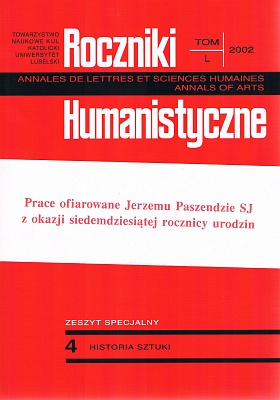Kilka uwag o nagrobkach Brzechffów i Branickich w pojezuickim kościele śś. Piotra i Pawła w Krakowie
Abstrakt
The article discusses two 18th century tombstones of the Brzechffa and Branicki families in St Peter and St Paul church in Cracow. They have already been mentioned in the subject literature as works by the architect Kacper Bażanka (by Olgierd Zagórowski) and – because of their morphology – as portal tombstones in which the door is the symbol of the passage from the world of the living to the world of the dead (by Jan Białostocki) and in which the door symbolizes the narrow gate (by Jan Samek).
Both the fact, confirmed by the sources, that the tombstones were sculptured by Bażanka, and the suggested symbolic meaning of the monuments do not raise doubts. The findings that are new or different from the accepted ones concern:
- contrary to Zagórowski’s thesis a mention in the archives has been preserved that indirectly says that the church fire in 1717 damaged the Brzechffa monument;
- the interpretation of the battle scene in the Branicki tombstone pointing to the battle of Vienna may be considered final, first of all on the basis of the autopsy of the polychromy, recently cleaned; the preserved letter by Jan III concerning the canonization of St Stanisław Kostka may be an additional argument here;
- the male busts in the Branicki tombstone probably portray the hetmans who were related to them: Crown Field Hetman Stefan Czarniecki and Lithuanian Grand Hetman Kazimierz Sapieha;
- the participation of the Jesuit Franciszek Noskowski, a teology and the Holy Writ professor, that is confirmed by the sources, allows one to see the inventor of the monument in him; he may have played a similar role in the origin of the Brzechffa monument, as he stayed in Cracow when it was being sculptured;
- the symbolic meaning of the tombstone portals may be complemented with the meaning of the gate as the place of judgement; because of the soul judgement the virtues of the dead are quoted. They are represented there by means of scenes in which the virtues are manifested and as personifications;
- the tombstones that are part of architectonic divisions of the chapels in the architect’s intention were supposed to create the impression that they are the decoration of the whole walls; their form refers to occasional decorations, e.g. for the occasion of a burial; this was due to the fact that only the appearance of an impermanent decoration allowed one to circumvent the ban on raising constant tomb monuments for lay people that was in force in Jesuit churches;
- the decoration of St Vincent and St Anastasius church in Rome prepared for the exequies of Cardinal Mazarini in 1661, probably designed by Giovani Francesco Grimaldi according to Elpidio Benedetti’s idea, was probably the immediate inspiration for both the discussed tombstones.
Copyright (c) 2002 Roczniki Humanistyczne

Utwór dostępny jest na licencji Creative Commons Uznanie autorstwa – Użycie niekomercyjne – Bez utworów zależnych 4.0 Międzynarodowe.





